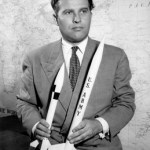 In the 1950s and ‘60s Berlin, bisected into eastern and western sections, was ground zero for the Cold War. One surprising arena for the head-to-head competition between the rival political systems/ideologies was the public zoological park. Before 1955 there was just one zoo in the divided city, the historic Zoologischer Garten in West Berlin, immensely popular and well patronised, not just by West Berliners but by citizens from the Eastern sector as well𝟙. In that year the East German Communist state established its own (East) Berlin zoo, called the Tierpark (literally “animal park”), to counter the popularity of the Zoologischer Garten. The rivalry between the two Berlin zoos for hegemony sustaining itself over the next 30-plus years would be a personal as well a political one.
In the 1950s and ‘60s Berlin, bisected into eastern and western sections, was ground zero for the Cold War. One surprising arena for the head-to-head competition between the rival political systems/ideologies was the public zoological park. Before 1955 there was just one zoo in the divided city, the historic Zoologischer Garten in West Berlin, immensely popular and well patronised, not just by West Berliners but by citizens from the Eastern sector as well𝟙. In that year the East German Communist state established its own (East) Berlin zoo, called the Tierpark (literally “animal park”), to counter the popularity of the Zoologischer Garten. The rivalry between the two Berlin zoos for hegemony sustaining itself over the next 30-plus years would be a personal as well a political one.

Zookeepers at 40 paces!
The new zoo in the East has the advantage of a dynamic, forceful director, zoologist (Curt) Heinrich Dathe, who managed to wrangle funds out of a cash-strapped GDR to enhance the zoo’s collections and facilities impressively. Construction of the new polar bear habitat for instance was financed by the Stasi (State secret police). When Heinz-Georg Klös took over as director of the Berlin Zoo in 1957 the competitiveness between the two zoos became deeply personal, with a bitter hatred developing and enduring between Dathe and Klös𝟚. The two directors were constantly engaging in contests of oneupmanship…if one zoo acquired a rhinoceros the other zoo got one, or as Jürgen Lange, director of West Berlin Aquarium, described the two men’s relationship: “if one of them buys a miniature donkey, the other buys a mammoth donkey” (Mohnhaupt). Sometimes Klös would get the upper hand…knowing that it was hard for the GDR to get certain exotic animals and that there was a shortage of raw materials in the East, he built an ape house which Dathe couldn’t muster the resources to reciprocate (Mohnhaupt & Frisch). Notwithstanding this, under Dathe the Tierpark was an instant success, so successful that by 1958 it was attracting 1.7 M visitors, 200,000 more than was going through the turnstiles of Berlin Zoo and Aquarium combined.


Proxy cultural war
Dathe modernised the look of his zoo with innovative flair while the Zoologischer Garten remained more of a traditional zoo…in 1963 the Tierpark opened the Alfred-Brehm-Haus, at that time the largest and most modern animal house in the world. Containing a massive 50,000-foot state-of-the-art facility for big cats, the Brehm-Haus boasted the first barless enclosures for lions and tigers. The Tierpark, with the advantage of boundless space (set on 160 hectares), eventually became the largest zoo in Europe𝟛. The GDR loudly trumpeted its modernised zoo, heralding it as a triumph of socialism over capitalism, the zoo which due to a shortage of labour in East Germany was built partly by citizen-volunteers. Meanwhile Klös anxious to keep up with Dathe, was busy adding to the Berlin Zoo’s species collection, making it the most biodiverse zoo in the world. The duelling zoos in Berlin had become showcases for each side in the Cold War conflict (Rotondi). When either zoo notched up some success it was taken as an endorsement of its political system, a symbol of superiority and the validation of its society.

End of the zoo wars
This cultural competitiveness between East and West, the preoccupation with demonstrating “who’s got the better zoo?”, purportedly asserted to be an indicator of a superior society and way of life, persisted right up to the collapse of the Eastern Bloc and Wiedervereubugung (German unification) in 1990…it was only in that year that “Professor” Dathe relinquished his iron-grip hold on the Tierpark. With unification came a thaw in the combative climate and a subsequent rapid shift from rivalry to cooperation between the Berlin zoos, symbolised by the appointment in 1991 of a single director in charge of both zoos.

Footnote: Zoomania As can be inferred from the above, zoos were and still are a big deal in Germany (in both the bisected and unified eras), a product of the salient fact that the Germans are basically “animal tragics”…it’s said that Berliners love animals more than people (Mohnhaupt), a measure of which is the astounding number of zoos Germany has, in a country smaller than the US state of Montana, they number more than 880!
 Image source: design-mkt.com
Image source: design-mkt.com─═─═─═─═─═─═─
𝟙 zoos provided the perfect diversion for Berliners from both sectors during the Cold War, availing them of the opportunity to escape from the city of walls and connect with the world of nature (Rotondi)
𝟚 the relationship deteriorating even to the point of a physical confrontation between the two zookeepers in Berlin Zoo’s elephant enclosure
𝟛 cf. the much smaller, cramped, inner city Zoologischer Garten with little space to expand
Bibliography
J.W. Mohnhaupt, The Zookeepers’ War, (2020)
‘Even Before the Wall, Berlin’s Zoos Were Already Cold War Rivals’, J.W. Mohnhaupt & Shelley Frisch, Time, 12-Nov-2019, www.time.com
‘The Cold War Rivalry Between Berlin’s Two Zoos’, Jessica Pearce Rotondi, History, 08-May-2023, www.history.com













 Endnote: Maphilindo, a still-born S.E. Asian association
Endnote: Maphilindo, a still-born S.E. Asian association



